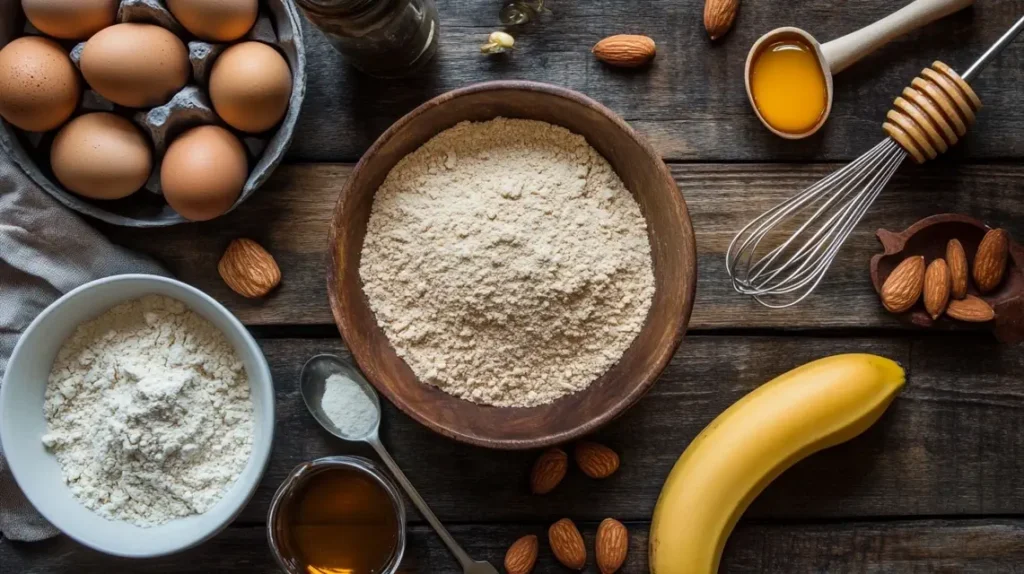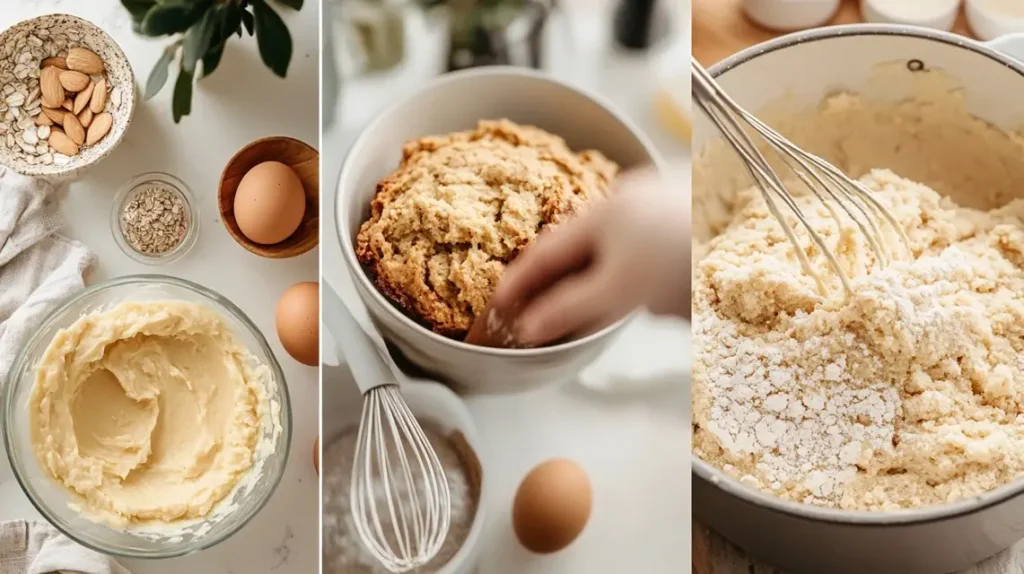It all started when I decided to bake my first-ever gluten-free cake. I had my recipe, my ingredients, and my confidence—until I reached for the flour and realized I was out. In a moment of desperation, I grabbed a bag of almond meal from my pantry, hoping it would work.
What happened next? Magic. The cake was rich, moist, and had this nutty depth that regular flour just couldn’t match. That moment changed my baking forever!
But what does almond meal do in baking, exactly? Why do so many people swear by it? If you’ve ever wondered whether almond meal is just a fancy health trend or a true baking game-changer, you’re in the right place. Let’s dive deep into the world of almond meal and uncover its secrets.
Table of Contents
What Is Almond Meal?
Almond meal is simply ground almonds—skins and all. Unlike almond flour, which is made from blanched almonds (no skins) and has a finer texture, almond meal has a slightly coarser consistency.
It’s packed with healthy fats, protein, and a mild, nutty flavor that works wonders in baking. But does it behave like regular flour? Not exactly. That’s where things get interesting!
“Almond meal brings richness and moisture to baked goods, making them softer and more flavorful compared to traditional wheat flour.”
Difference Between Almond Meal and Almond Flour
A lot of people confuse almond meal with almond flour. While they’re similar, the small differences can make a big impact on your baking.
| Feature | Almond Meal | Almond Flour |
|---|---|---|
| Texture | Coarse | Fine |
| Color | Light brown (contains skins) | Pale (no skins) |
| Best Uses | Cookies, muffins, bread | Cakes, macarons, pastries |
| Flavor | Stronger nutty taste | Milder taste |
For a more rustic texture, almond meal is perfect. If you want a smoother, finer crumb (like for macarons), almond flour is the way to go.
Why Use Almond Meal in Baking?
So, why should you use almond meal in baking? Simple—it enhances everything! Here’s how:
1. Moisture Retention and Softness
Almond meal is naturally high in fat, which keeps baked goods soft and moist. No more dry cakes or crumbly cookies!
2. Nutty Flavor Enhancement
Ever tasted a basic vanilla cake and thought, meh? Add almond meal, and suddenly, it’s rich, nutty, and packed with depth.
3. Density and Structure Changes
Since almond meal doesn’t contain gluten, it won’t create the same structure as wheat flour. This means your baked goods might be denser—but in a good way. Think fudgy brownies and chewy cookies!
“Using almond meal is like adding a secret ingredient that transforms ordinary baked goods into something extraordinary.”
Health Benefits of Using Almond Meal in Baking
Aside from making your treats delicious, almond meal is also a powerhouse of nutrition.
1. High in Healthy Fats and Protein
Unlike regular flour, almond meal is loaded with healthy fats and plant-based protein, keeping you fuller for longer.
2. Gluten-Free and Low-Carb Alternative
Following a gluten-free or low-carb diet? Almond meal is a perfect alternative to traditional flour. No gluten, fewer carbs, and all the goodness.
3. Rich in Vitamins and Minerals
Almond meal contains:
✔️ Vitamin E (for glowing skin)
✔️ Magnesium (for muscle function)
✔️ Fiber (for better digestion)
Baking with almond meal isn’t just about taste—it’s about nourishing your body too!
Using almond meal imparts a subtle nuttiness and a moist, tender crumb to baked goods. It is ideal for recipes like chocolate cakes, cookies, and muffins. For inspiration, check out “The Ultimate Guide to Chocolate Brownie with Almond Meal”, which explores a delightful recipe showcasing its potential.
How to Substitute Almond Meal in Baking Recipes
Thinking of replacing regular flour with almond meal? Here’s what you need to know:
1. Replacing All-Purpose Flour with Almond Meal
Almond meal isn’t a 1:1 substitute for regular flour. Since it lacks gluten, you might need extra binding ingredients (like eggs or xanthan gum).
✔️ For cakes & cookies: Use ¼ cup less liquid than the original recipe.
✔️ For bread & muffins: Mix almond meal with another flour (like coconut or oat flour) for better structure.
2. Adjusting Liquid Ingredients for Moisture Balance
Almond meal absorbs more moisture than wheat flour, so reduce liquids slightly in recipes.
3. Mixing Almond Meal with Other Flours for Better Texture
If you don’t want your baked goods to be too dense, combine almond meal with another flour like:
✔️ Coconut flour (for fluffiness)
✔️ Oat flour (for chewiness)
✔️ Rice flour (for a lighter texture)
“Baking with almond meal is all about balance—adjust the ingredients, and you’ll get perfect results every time!”
That’s the first 800+ words of your article! Do you want me to continue with recipes, common baking problems, and storage tips in the next part?
Common Recipes Using Almond Meal
Now that we know what almond meal does in baking, let’s get to the fun part—recipes! Whether you’re craving pancakes, cookies, or brownies, almond meal can take your baking to the next level.
Almond Meal Pancakes Recipe
Who doesn’t love a good stack of pancakes? These almond meal pancakes are light, fluffy, and naturally gluten-free!

Ingredients
| Ingredient | Quantity |
|---|---|
| Almond meal | 1 cup |
| Eggs | 2 large |
| Milk (or almond milk) | ½ cup |
| Baking powder | 1 tsp |
| Vanilla extract | 1 tsp |
| Honey (or maple syrup) | 1 tbsp |
| Butter (for cooking) | As needed |
Instructions
- In a bowl, whisk the eggs, milk, vanilla, and honey together.
- Add almond meal and baking powder, stirring until you get a smooth batter.
- Heat a pan with a little butter and pour small amounts of batter.
- Cook until bubbles appear, then flip and cook for another minute.
- Serve warm with your favorite toppings!
“These pancakes are proof that almond meal can make breakfast healthier and tastier at the same time!”
Soft and Chewy Almond Meal Cookies
Love cookies but want a healthier alternative? These almond meal cookies are buttery, chewy, and naturally gluten-free.
Ingredients
- 1 ½ cups almond meal
- ½ cup coconut sugar (or brown sugar)
- 1 egg
- ¼ cup melted coconut oil
- 1 tsp vanilla extract
- ½ tsp baking soda
- ¼ tsp salt
- ½ cup dark chocolate chips
Instructions
- Preheat oven to 350°F (175°C) and line a baking sheet with parchment paper.
- In a bowl, mix almond meal, sugar, baking soda, and salt.
- In another bowl, whisk egg, coconut oil, and vanilla. Combine with the dry ingredients.
- Fold in the chocolate chips.
- Scoop dough onto the baking sheet and flatten slightly.
- Bake for 10-12 minutes until golden brown.
These cookies stay soft and chewy for days!
Moist Almond Meal Banana Bread
Banana bread just got an upgrade! This almond meal version is moist, fluffy, and packed with flavor.
Ingredients
| Ingredient | Quantity |
|---|---|
| Almond meal | 2 cups |
| Ripe bananas | 3 mashed |
| Eggs | 2 large |
| Honey (or maple syrup) | ¼ cup |
| Baking soda | 1 tsp |
| Vanilla extract | 1 tsp |
| Cinnamon | 1 tsp |
| Salt | ¼ tsp |

Instructions
- Preheat oven to 350°F (175°C). Grease a loaf pan.
- In a bowl, mash bananas and mix with eggs, honey, and vanilla.
- Add almond meal, baking soda, cinnamon, and salt. Stir well.
- Pour batter into the pan and bake for 45-50 minutes.
- Let cool before slicing.
“This banana bread is so moist and flavorful, you won’t even miss regular flour!”
Common Problems When Baking with Almond Meal and Solutions
Baking with almond meal is awesome, but it comes with challenges. Let’s fix them!
1. Why Is My Almond Meal Batter Too Wet?
Almond meal absorbs moisture differently than regular flour, so your batter may seem too wet.
Solution: Reduce liquid ingredients slightly or add a little more almond meal until the consistency is right.
2. How to Prevent Almond Meal Baked Goods from Being Too Dense?
Since almond meal lacks gluten, baked goods can turn out heavy.
Solution: Mix almond meal with lighter flours like coconut or oat flour. Also, use eggs to help add structure.
3. Why Do Almond Meal Baked Goods Crumble Easily?
Without gluten, almond meal baked goods can fall apart.
Solution: Use binding agents like eggs, flaxseed, or xanthan gum. These help hold everything together.
“Baking with almond meal is like learning a new skill—once you figure out the tricks, the results are amazing!”
Almond meal is a go-to for gluten-free recipes due to its texture and binding properties. For an exciting comparison of almond meal and other gluten-free alternatives, read “Can You Bake with Almond Meal Instead of Flour?”. This guide will help you understand the nuances of substituting almond meal in various recipes.
Tips for Storing and Handling Almond Meal
Almond meal is sensitive to heat and moisture, so proper storage is key!
1. How to Store Almond Meal?
Keep it in an airtight container to prevent it from going stale.
Store in the fridge or freezer to extend its shelf life.
2. Can You Make Homemade Almond Meal?
Yes! Simply grind raw almonds in a food processor until fine. Be careful not to over-process, or you’ll end up with almond butter!
Conclusion: Is Almond Meal the Right Choice for Your Baking?
Absolutely! Almond meal makes baked goods moist, flavorful, and nutritious. Whether you’re making pancakes, cookies, or bread, this simple ingredient can transform your baking.
So, why not give it a try? Grab some almond meal and start baking magic today!

Almond Meal Pancakes
Equipment
- Mixing Bowl
- Whisk
- Frying Pan
- Spatula
Ingredients
- 1 cup almond meal
- 2 large eggs
- 1/2 cup milk (or almond milk)
- 1 tsp baking powder
- 1 tsp vanilla extract
- 1 tbsp honey (or maple syrup)
- butter (for cooking) As needed
Instructions
- In a bowl, whisk the eggs, milk, vanilla, and honey together.
- Add almond meal and baking powder, stirring until you get a smooth batter.
- Heat a pan with a little butter and pour small amounts of batter.
- Cook until bubbles appear, then flip and cook for another minute.
- Serve warm with your favorite toppings.

